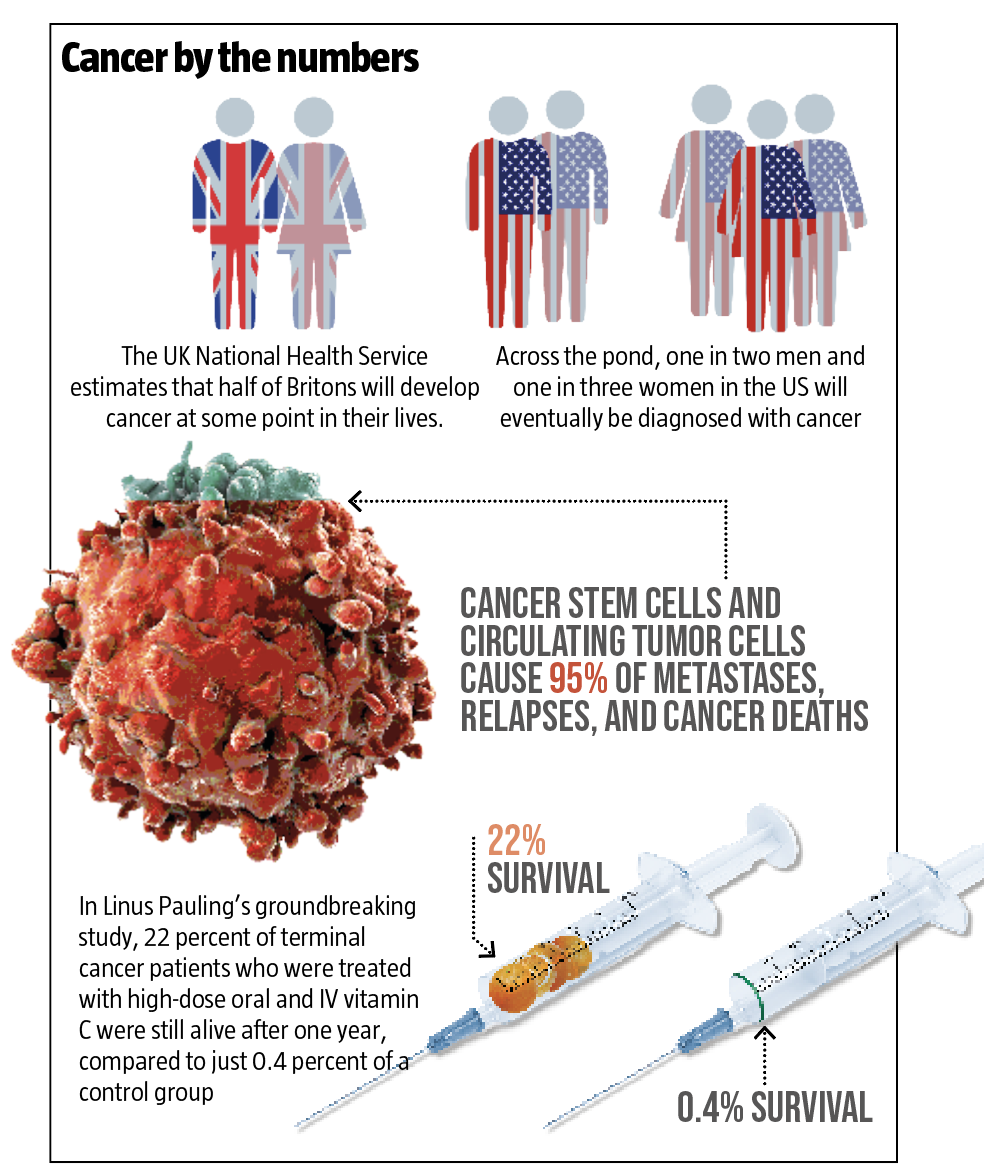
Dr Leigh Erin Connealy, who runs the Cancer Center for Healing, one of the largest and most advanced integrative clinics of its kind in North America, begins her column on the best integrative approaches to healing cancer.
The UK National Health Service reports that one in two people in the UK will develop cancer at some time in their lives. This is a stark and rather frightening statistic, not only because cancer is a leading cause of death but also because the usual treatments are almost as scary as the disease itself.
You probably know someone who has endured toxic, painful and sometimes disfiguring treatments, only to lose their battle against cancer or experience a relapse and have to face it all over again. According to a 2021 survey, 40 percent of British adults say their lives have been “significantly affected” because a close friend or family member has had cancer.
As a conventionally trained medical doctor, I appreciate the advances in cancer care over the past few decades. I would not hesitate to recommend surgery, radiation, chemotherapy or immunotherapy for the types of cancer they have been proven to help. I also recognize the value of blood tests, X-rays, MRIs, CTs and other tests and use them in my clinic for cancer screening, diagnosis and monitoring.
Yet I learned early in my medical career that they are not enough. Routine blood tests and imaging scans are great at detecting obvious tumors and metabolic irregularities, but they miss more subtle signs of cancer. Surgery, radiation and drugs may get rid of a tumor, but that doesn’t mean the cancer is cured, and they often inflict horrendous collateral damage. What good is getting rid of a tumor if the patient’s health is destroyed in the process?
There is a better way, one that marries the best of conventional medicine with treatments that most doctors ignore. A tumor may manifest in one organ, but a patient is more than a collection of body parts. To truly engender health, it is critical to treat the whole person—physical, emotional, mental and spiritual. This is the gist of integrative medicine.
At my Cancer Center for Healing, we have treated thousands of patients from all over the world, concentrating on four main pillars of integrative cancer care: prevention, early detection, supportive care and groundbreaking cancer treatments.
Cancer doesn’t happen overnight. It takes about 10 years for a single cancer cell to develop into a full-blown tumor. We all have cancer cells in our bodies at this very moment, which our immune systems are working 24/7 to eradicate.
Supporting your immune system and overall health with integrative therapies is your best bet for eliminating abnormal cells before they develop into malignancies.
Nevertheless, one in two men and one in three women in the US will eventually be diagnosed with cancer, and the earlier it is treated, the better the outcomes. Screening programs to detect early-stage cancer and precancerous changes save lives, but they are not infallible. Some cancers are missed, and others are overdiagnosed, leading to unnecessary biopsies and treatments.
Integrative doctors dig deeper. We assess our patients’ immune function, nutritional status, heavy metal burden, hormone levels and emotional energy patterns—all of which play a critical role in making the body a hospitable environment for cancer.
We also do extensive blood marker analysis, including a cutting-edge test, which is often referred to as a “liquid biopsy,” for both early detection and monitoring patients during and after their treatment courses.
This test looks for tumor markers in the blood, specifically cancer stem cells (CSCs) and circulating tumor cells (CTCs). These cells, which are shed by tumors, travel through the bloodstream looking for the next place to take up residence.
Because they are impervious to chemo and radiation, they often remain in the body, even after a patient has no obvious signs of cancer and is declared to be in remission. As one of the few ways of discovering the presence of CSCs and CTCs1—which are responsible for 95 percent of metastases, relapses, and cancer deaths—this test is detection at its very earliest.
Many of the patients we see are also receiving or have received chemotherapy or radiation. The side-effects of these treatments are well known and include fatigue, nausea and vomiting, hair loss, muscle wasting and brain fog. At my center, we have helped thousands of patients with supportive integrative therapies that reduce and, in some cases, prevent these adverse effects.
Supportive care also includes boosting the immune system, which is the body’s major defense against cancer and all diseases. Cancer overworks the immune system, and conventional cancer treatments further weaken it. I am always amazed when my patients tell me that their oncologists offer no suggestions for immune enhancement. This should always be a priority!
Another essential to successful cancer treatment is for the patient to adopt a healthy lifestyle, including restorative sleep, moderate exercise and a nutrient-rich diet that avoids sugars and other foods that impair immunity and fuel cancer growth. I prescribe a robust supplement program with high doses of vitamin C and D3, coenzyme Q10, curcumin, melatonin and other immune-boosting nutrients.
I also stress the importance of avoiding environmental pollutants such as toxic cleaning and personal care products, mold, electromagnetic field (EMF) pollution and other contaminants and creating a healthy, healing “anticancer environment.” If testing reveals elevated levels of cancer-causing lead, mercury or other heavy metals, as it often does, a detoxification program may be indicated.
The integrative approach emphasizes emotional and mental health as well. A diagnosis of cancer is tremendously stressful, and stress in and of itself does a number on your health.
Complementary therapies such as acupuncture, yoga, meditation and energy medicine are important tools for relieving stress and improving quality of life. Individual and group counseling and support are also essential during this turbulent time, not only for patients but also for loved ones who are accompanying them on this journey.
Integrative cancer care goes beyond support and prevention to include a number of safe, nontoxic therapies that directly target cancer cells. Although these treatments have not been embraced by conventional oncology, they are backed by solid scientific research, used by thousands of patients and supported by clinical success.
At my clinic, we use high-dose intravenous (IV) vitamin C (see below), hyperbaric oxygen, low-dose chemotherapy, ozone therapy, insulin potentiation therapy, pulsed electromagnetic field therapy (PEMF) and hyperthermia, to name a few. Not every treatment is effective for everyone or every type and stage of cancer, so we help our patients determine the best combination of treatments.
Optimal outcomes require a broad, holistic, personalized regimen of lifestyle changes, nutritional and emotional support, and the most effective cancer-killing therapies—both conventional and alternative. That’s what integrative cancer care is all about: improving patients’ lives with the very best that medicine has to offer.
In forthcoming columns, I’ll elaborate on each of these pillars of integrative cancer care and outline a lifestyle program you can adopt at home.
One of the mainstays of my treatment is high-dose IV vitamin C. Everyone knows vitamin C is an important antioxidant. It is found in multivitamins, and many people take higher doses to boost immune function and reduce their risk of respiratory infections.
Vitamin C also plays a role in carbohydrate, fat and protein metabolism, and is required for the formation of collagen, a protein that is a structural constituent of skin, bone, cartilage and other connective tissues.
Research reveals that in addition to enhancing immune function, supplemental vitamin C protects against diabetic complications, cardiovascular disease, gout, cataracts and age-related macular degeneration. Applied topically, vitamin C also helps repair sun damage to the skin.
And when given intravenously, vitamin C has powerful anticancer effects.
This was first reported back in the 1970s, when Nobel laureate Linus Pauling, PhD, and Ewan Cameron, MD, published a study showing that patients with terminal cancer who were treated with high-dose oral and IV vitamin C had significantly increased survival times. After one year on these treatments, 22 percent of them were still alive, compared to just 0.4 percent of a control group.2
This led researchers at the Mayo Clinic to conduct a clinical trial of vitamin C for patients with advanced cancer. The results were null: vitamin C did not improve outcomes. There is an easy explanation for this. Unlike the initial studies, the subsequent research used only oral vitamin C. No intravenous C was used at all—and this made all the difference.
A cynic might say this was intentional. After all, chemotherapy and radiation were the accepted treatments at the time, and they still are. No one expected an inexpensive vitamin to work, and the study design made sure it didn’t. In any case, that pretty much put an end to further research.
With the exception of a handful of alternative physicians who continued to successfully treat cancer patients, IV vitamin C was virtually ignored.
Then, in the early 2000s, Mark Levine, MD, a researcher of some renown at the US National Institutes of Health, picked up the baton. In a 2005 study, he and his team demonstrated that high concentrations of vitamin C do indeed kill cancer cells.3
Of the 10 cancer cell lines and four types of normal cells they tested, vitamin C was highly toxic to five cancer lines—but it was shown to have no adverse effects on normal cells.
The researchers discovered that, in high concentrations, vitamin C reacts with iron in the blood to generate large amounts of hydrogen peroxide. Hydrogen peroxide is lethal to many types of cancer cells, but normal cells are protected by an enzyme called catalase that breaks down hydrogen peroxide and renders it harmless.
Dr Levin and colleagues also found that the only way to achieve these high concentrations is with intravenous infusions. The body controls vitamin C levels by curbing the amount that the intestinal tract can absorb at one time. Excess vitamin C is excreted, which is why high doses cause loose stools in some people. IV infusions bypass this control mechanism, resulting in blood levels that may be 100 times higher than what could be achieved from a similar oral dose.

Laboratory studies have demonstrated that IV vitamin C decreases cell proliferation in lymphoma and cancers of the prostate, pancreas, lung, colon, breast, ovary and brain. This therapy has also performed well in case studies and clinical trials,4 although they are limited due to the absence of a profit motive in researching safe, natural therapies that could compete with the drugs in Big Pharma’s arsenal.
One recent case history concerns a man with advanced pancreatic ductal adenocarcinoma, a cancer that has a dismal prognosis and a five-year survival rate of just 6 percent. After opting for high-dose IV vitamin C as his only treatment, the patient lived nearly four years after diagnosis. He actually had documented tumor regression until succumbing to sepsis from a bowel perforation.5
In addition to its direct anticancer effects, IV vitamin C significantly improves quality of life, which is particularly important for patients with advanced cancer or those who are undergoing conventional treatments. We have treated many patients during their chemotherapy regimens, and they usually report reductions in chemo-related nausea, vomiting, fatigue and other side-effects.
IV vitamin C is usually administered as part of a multifaceted treatment program that may include conventional therapies as well as a range of integrative modalities.
Treatments simply involve relaxing in a recliner while an individualized dose of vitamin C is slowly infused into a vein over a couple of hours. The frequency of treatments depends on several variables, but it is usually administered twice a week. IV vitamin C is safe and well-tolerated, even at high doses.

Dr Leigh Erin Connealy, MD, is the Medical Director of the Cancer Center for Healing and the Center for New Medicine in Irvine, California. Author of The Cancer Revolution and Be Perfectly Healthy and a sought-after speaker who has appeared on numerous TV and radio shows, webinars and podcasts, Dr Connealy has been named one of the Top Functional and Integrative Doctors in the US.
|
References |
|
|
1 |
Cancers (Basel), 2020; 12(4): 867 |
|
2 |
Proc Natl Acad Sci USA, 1976; 73(10): 3685–9 |
|
3 |
Proc Natl Acad Sci USA, 2005; 102(38): 13604–9 |
|
4 |
Antioxidants (Basel), 2021; 10(12): 1894; J BUON, 2021 Nov 1; 26; Antioxidants (Basel), 2018; 7(7): 89 |
|
5 |
Anticancer Drugs, 2018; 29(4): 373–9 |